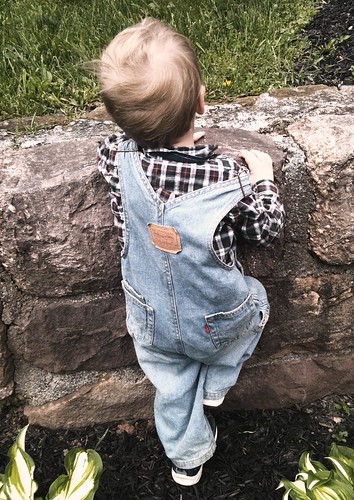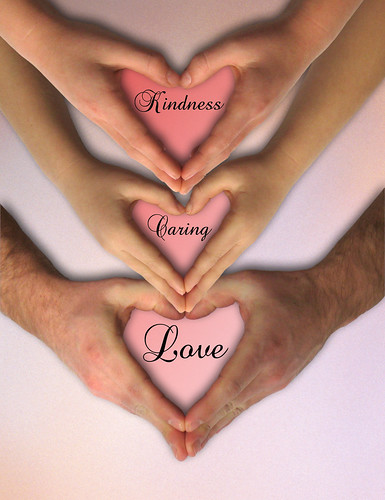He isn’t a baby anymore. He’s growing in leaps and bounds, and scaling new heights every day, in every way. As his world grows larger and he begins to play with other children besides his sister (who has been the world to him up to now), both the physical and the emotional challenges he faces are bigger. At the park last week, J. worked and worked, and was finally able to scrabble up the “big” rock. He sat at the top, next to B. (a little boy we know from our neighborhood, who at almost four years old, is about a year and a half older than J.).
B.’s Mom and I were standing nearby, chatting. Suddenly J. was falling, and he landed face down on the ground next to the rock. I quickly moved in close, and J. lifted his arms to indicate he wanted me to pick him up, while emitting a heartrending sob. I held him close, and gently rubbed his back. I could feel his chest heaving against mine. I wanted to take a look and make sure he wasn’t bleeding anywhere, but he was clinging to me tightly. In between sobs, he choked out these words – “B. p…p…p…pushed m…m…me!” I could hear the shock and bewilderment in his voice. I understood that while the fall may have hurt, the fact that he had been pushed by a friend hurt more.
In that moment, I felt my stomach clench, and a flash of anger ran through me like a current. My thoughts went something like this: “Why???would B. push J.? How could he? J. is one of the most gentle children I know. He was just sitting there! B. is older- he should know better. How would he like it if someone (like me) pushed him off the rock?” (I know, I know- I’m supposed to be a professional. I’m supposed to know and understand that these things happen, that it’s all part of life and learning, and that both children are in need of compassion. And I do know it, and I practice it.) But in that moment, it was my J. that was hurt and sobbing because another child had intentionally (and stealthily) pushed him.This was the first time something like this had happened to J. in the two and a half years I’d been caring for him. Somehow, in my heart and mind the fall was worse because someone else had purposely caused him to lose his balance. I felt protective- a little like a Mama Bear maybe- “Don’t even think about hurting my baby or I’ll hurt you!” But it turned out J. didn’t need my protection, as evidenced by what happened next.

B.’s Mom had heard what J. had said, as had B., who had made a quick exit from the scene. As I continued to comfort J., B’s Mom brought him back over to where we were, and asked him if he had pushed J. She was clearly upset and flustered. She was both apologizing to me and telling B. he had to apologize to J. B., meanwhile, wouldn’t look at her, and was trying to squirm away. I was still holding J., who indicated he wanted to get down. Still hiccuping, he walked right up to B., looked him in the eye, and very clearly said, “B. don’t push me! I not like it! You not push me again!” B.’s Mom insisted B. had to apologize to J., and B. offered a halfhearted, “I’m sorry,” but J. had said what he had to say, and he wasn’t holding any grudges. He was ready to go back to playing. “Come on B.! Want to climb the rock?” Fifteen minutes later, when it was time for us to leave the park, J. was happily waving and calling, “Goodbye B.! Bye, bye! We see you soon.” I spent the last fifteen minutes at the park reassuring B.’s Mom, who was distraught that this “problem with pushing was coming up again.”
I stood humbled and in awe of J., who, at two and a half years old, demonstrated an ability to clearly express his feelings and boundaries, while navigating a difficult situation with grace and forgiveness, which is something I sometimes still struggle to manage to do easily. Young he is, vulnerable he may be, and certainly he needed the comfort of my arms, and my listening ear when he had been hurt, but how amazing to realize his ability to negotiate a friendship on his own terms. I wonder why it’s so hard for us “grown-ups” to do the same?
Is it hard or easy for you to let your child take new physical or emotional risks? What feelings come up for you when your child is hurt? Are the feelings the same or different when the hurt is caused by someone else’s actions? How much do you think adults should intervene in children’s interactions or conflicts?

 In “Peaceful Babies—Contented Mothers,” pediatrician Dr. Emmi Pikler asks us to consider the importance of the touch of our hands.
In “Peaceful Babies—Contented Mothers,” pediatrician Dr. Emmi Pikler asks us to consider the importance of the touch of our hands.